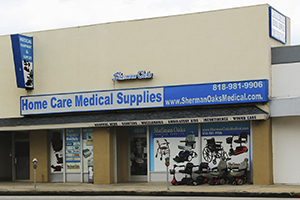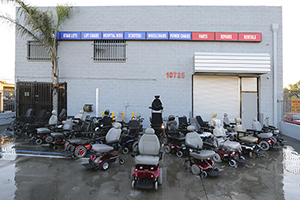Mobility Scooters Guide

A Mobility Scooter is a mobility aid similar to a Power Wheelchair but configured like a motor scooter. It is often referred to as a power-operated vehicle/scooter or electric scooter as well.
A Mobility Scooter has a seat over two rear wheels, a flat area for the feet, and handlebars in front to turn one or two steerable wheels. The seat may swivel to allow access when the front is blocked by the handlebars. Mobility Scooters are usually electric-powered. A battery or two is stored onboard the Scooter, and is charged via an onboard or separate charger unit from standard electric outlets. Gasoline-powered Mobility Scooters are also available, though they are rapidly being replaced by electric models.
The tiller, with forward/reverse directions and speed controls, is the steering column centrally located at the front of the Mobility Scooter. Direction can be controlled by thumb paddles, finger controls or a switch. There are two types of Mobility Scooters: front-wheel drive (FD) or rear-wheel drive (RD). The FD is usually a smaller device and best used indoors. Rider weight capacity is generally upwards to 250 pounds maximum. The RD Mobility Scooter is used both indoors and outdoors with rider weight capacity of 350 pounds. A heavy duty RD Mobility Scooter is capable of carrying up to 500 pounds, varying by manufacturer.
The first Mobility Scooter, the Amigo, was built in 1968 by Allan R. Thieme in Bridgeport, Michigan. This front-wheel drive model was built specifically to assist a family member with multiple sclerosis regain their independent mobility. Mobility Scooters are now available in a wide range of models, from tiny folding travel Mobility Scooters to heavy-duty bariatric Mobility Scooters. Mobility Scooters are commonly available for loaner use at public facilities, such as amusement parks or grocery stores.
Advantages of Mobility Scooters
Assistive and small sit-down motor Scooters provide important advantages to people with Mobility problems throughout the world. A Mobility Scooter is useful for persons without the stamina or arm/shoulder flexibility necessary to use a Manual Wheelchair. Also, swiveling the seat of a Mobility Scooter is generally easier than moving the foot supports on most conventional Manual Wheelchairs. A Mobility Scooter is very helpful for persons with systemic or whole-body disabling conditions (coronary or lung issues, some forms of arthritis, etc.) who are still able to stand and walk a few steps, sit upright without torso support, and control the steering tiller.
A main selling point of the Mobility Scooter is that it does not look like a Manual Wheelchair, which many people see as a sign of old age. However, as increasing numbers of elderly persons choose Mobility Scooters, the Scooter is now developing its own reputation, at least among the able-bodied, as a geriatric item. Mobility Scooters are generally more affordable than Power Wheelchairs, and often easier to obtain from insurers or health care agencies.
Limitations of Mobility Scooters
While a Mobility Scooter eliminates much of the manual strength problems of a Manual Wheelchair, its tiller steering mechanism still requires upright posture, shoulder and hand strength, and some upper-body Mobility and strength. Other drawbacks of Mobility Scooters are their longer length, which limits their turning radius and ability to use some lifts or Manual Wheelchair-designed access technologies such as kneeling bus lifts. It can also make it difficult to navigate nursing home rooms, where space is often limited. Mobility Scooters also have fewer options for body support, such as head or leg rests. They are rarely designed for ease of patient transfer from seat to bed. These limitations may prevent some disabled individuals from using Mobility Scooters. In addition, Mobility Scooter limitations may vary depending on model and manufacturer. A limitation of one make/model does not necessarily carry over to all. Individual needs may affect the suitability of a particular model.
Our service area covers most of Southern California including Los Angeles and surrounding cities.
To see a full list of cities covered in our service area please click here.
- Agoura Hills
- Alhambra
- Altadena
- Arcadia
- Arleta
- Artesia
- Avalon
- Azusa
- Baldwin Park
- Bel Air
- Bell
- Bell Gardens
- Bellflower
- Beverly Hills
- Bradbury
- Brentwood
- Burbank
- Cahuenga Pass
- Calabasas
- Camarillo
- Canoga Park
- Carson
- Cerritos
- Chatsworth
- Claremont
- Commerce
- Compton
- Covina
- Cudahy
- Culver City
- Diamond Bar
- Downey
- Duarte
- Eagle Rock
- El Monte
- El Segundo
- Encino
- Gardena
- Glendale
- Glendora
- Granada Hills
- Hawaiian Gardens
- Hawthorne
- Hermosa Beach
- Hidden Hills
- Huntington Park
- Industry
- Inglewood
- Irwindale
- Kagel Canyon
- La Canada
- La Crescenta
- La Habra Heights
- La Mirada
- La Puente
- La Tuna Canyon
- La Verne
- Lake Balboa
- Lake View Terrace
- Lakewood
- Lancaster
- Lawndale
- Lomita
- Long Beach
- Los Angeles
- Lynwood
- Malibu
- Manhattan Beach
- Marina Del Rey
- Maywood
- Mission Hills
- Monrovia
- Montebello
- Monterey Park
- Montrose
- NoHo Arts District
- North Hills
- North Hollywood
- Northridge
- Norwalk
- Oak Park
- Olive View
- Oxnard
- Pacific Palisades
- Pacoima
- Palmdale
- Palos Verdes
- Panorama City
- Paramount
- Pasadena
- Pico Rivera
- Pomona
- Porter Ranch
- Redondo Beach
- Reseda
- Rolling Hills
- Rosemead
- San Dimas
- San Fernando
- San Gabriel
- San Marino
- Santa Barbara
- Santa Clarita
- Santa Fe Springs
- Santa Monica
- Sepulveda
- Shadow Hills
- Sherman Oaks
- Sierra Madre
- Signal Hill
- Simi Valley
- South El Monte
- South Gate
- South Pasadena
- Stonehurst
- Studio City
- Sun Valley
- Sunland
- Sylmar
- Tarzana
- Temple City
- Thousand Oaks
- Toluca Lake
- Toluca Woods
- Topanga
- Torrance
- Tujunga
- Valencia
- Valley Glen
- Valley Village
- Van Nuys
- Ventura
- Vernon
- Walnut
- Warner Center
- West Covina
- West Hills
- West Hollywood
- West Toluca
- Westlake Village
- Westwood
- Whittier
- Winnetka
- Woodland Hills




 Accreditation Commission for Health Care
Accreditation Commission for Health Care
 RESNA Accredited
RESNA Accredited





